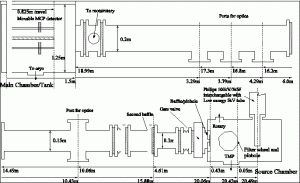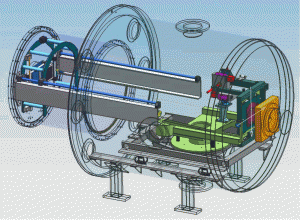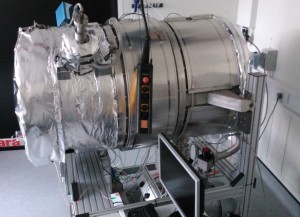AHEAD 2015-2019
Installation 2: Vacuum Bakeout Camera (VBC)
Installation 1
A document providing more detailed description of LLBTF is available here.
LLBTF – The Leicester Long Beam-line Test Facility (LLBTF) is a (nominally) 27.5m-length vacuum beam-line with an X-ray source enclosure at one end and an experimental chamber at the other. The experimental chamber opens into a class 1000 clean room to allow samples to be loaded and unloaded in a clean environment. The X-ray source chamber is pumped by a turbo-molecular pump and normally achieves pressures ~5×10−7 mbar. The source can be isolated from the beam-line so that either part can be vented independently. A number of different sources can be used: (1) low-voltage electron-bombardment source with Cu anode (various characteristic X-ray lines can be generated by coating the anode with other materials; maximum anode voltage approx 8kV); (2) 50kV 1mA sealed tubes with Mo target and Be window; (3) 100kV 3kW Philips tubes with Tungsten and Sc anodes; (4) Deuterium lamp and monochromator. Included in the chamber is a filter wheel for provision of transmission filters and or collimating apertures. A range of standard filters is available for C-K, Cu-L, Al-K and Si-K. Other energies can be produced. The Philips tube can also be configured to bombard a target to produce fluorescence X-rays. The X-ray sources use thin-film transmission filters only; no X-ray monochromator is available. The use of the 50kV or 100kV tubes needs to give due consideration to radiation safety at the experiment and must be discussed with ULEIC staff.
The beam-line has an experimental chamber located at the mid-way point, with a high-precision linear drive station (Newport M-MTM200PE.1V6 200mm travel 0.1μm resolution). This equipment is not integrated with the system control software. Four other (non-instrumented) access ports are available between the centre point and the experimental chamber, for user-provided equipment. The experimental tank consists of a main chamber which is 1.25m in diameter and 1.5m long. In addition there is a permanently attached extension chamber which is approximately 0.76m diameter by 0.7m long. The tank utilises a cryogenic pump and roughed out using a roots/rotary pump combination. The tank base pressure is < 2×10−6 mbar. Mounting and connection of the cryo pump are configured so as to avoid transfer of vibration to the chamber. All adjustments can be made while the system is under vacuum and operational using UHV-compatible vacuum stepper motors. The system is designed to uniformly illuminate optics up to 210mm diameter. A PN diode beam monitor allows the spatial and spectral variability of the beam to be mapped. The turret assembly is a high precision rotation stage which allows the item under test to be rotated in ψ and φ. Nominal stability and repeatability of the rotation is better than 10 arc seconds. The system is also set up to rotate up to six samples into the beam one after the other by rotating a sample carrier about the X-ray beam (θ). The turret can be rotated through 180 degrees to allow easy loading of samples and can be used in the forward position or in the back position facing the detector. The nominal mounting area for items on the turret is 208mm (h) by 250mm (v), however it may be possible to accommodate larger items. The maximum mass that can be accommodated on the turret is about 5kg. The system includes a large active area, 90mm × 90mm, imaging MCP detector which is mounted on a three-axis movement. A set of IDL-based, image acquisition and control programs is used to adjust the position of the detector, turret and beam monitor and acquire image data from the detector. The system allows manual control but is also designed to automatically take multiple data sets under computer control. Image data from the MCP detector can be provided as either event lists or as linearised images. All data will be the property of the experimenter but ULEIC reserve the right to use the data to check on the operation and calibration of the facility. Normal control of the system is from a laboratory area outside the clean room. The normal manned operating hours of the test facility are 0800 to 1800 Monday to Friday but the test facility can acquire data 24 hours a day under computer control. It is not possible to control the facility using a remote connection, all measurement sequences have to be set up from the laboratory area. The operation of the facility will be done by ULEIC employees with the aim of carrying out the experimental plan for the tests in the most efficient way. All equipment to be tested under vacuum must be suitable for use in clean high vacuum. All user-supplied electrical equipment must have been tested for electrical safety within the last 12 months.
The long beam-line test facility is located in the basement of the Physics & Astronomy Building at the University of Leicester and is operated by staff from the Space Research Centre. The facility has been substantially refurbished over the last 10 years but has been in use since the mid-1970s and was used to calibrate detectors for Ariel 5, Ariel 6, EXOSAT and Ginga missions. Currently the facility is being used to test and calibrate the MIXS optics for ESA’s BepiColombo mission to Mercury as well as supporting laboratory programmes in X-ray Interferometry and Smart X-ray Optics.
Installation 2 Vacuum Bakeout Camera (VBC)
Instrumentation (optics, sensors etc) and other equipment (structural parts, electronics boards, mechanisms) to be placed in vacuum – either in on-ground test facilties or during flight in space – often requires ‘bakeout’ prior to vacuum exposure in order to remove potential contaminants such as hydrocarbons and water which could adversely affect the instrument under test or the environment (vacuum test chamber, spacecraft bus etc). The ULEIC Vacuum Bakeout Chamber (VBC) is sited within a clean (ISO6), AIV area in the Space Research Centre (SRC), permitting appropriate handling of contamination-sensitive equipment.
The chamber has a capacity of ~0.6 m3 (0.8 m diameter x 1.2 m length), is equipped with two jacket heaters, a rotary-pump-backed turbomolecular pump, a Faraday mass spectrometer for residual gas analysis (RGA), a temperature controlled Quartz Crystal Microbalance (TQCM), vacuum gauges, feedthroughs for temperature-control instrumentation and a gaseous nitrogen backfill system for clean return to ambient pressure. The heater system can achieve a maximum chamber temperature of 125 C, and uses feedback from two PRTs to control the temperature of the baked items. A further ‘watchdog’ PRT is linked to a separate automatic heater shutdown to provide additional protection against exceeding temperature limits.
The VBC was commissioned in 2006 in conjunction with the JWST-MIRI project (for which ULEIC is the mechanical systems lead). It has been used to date for bakeout to ESA/NASA standards, for several JWST-MIRI subsystems and for BepiColombo-MIXS, including cases with sensitive optical surfaces, instances where the temperature limit had to be closely monitored and safeguarded, and contracted work for international partner organisations in Europe.
The LLBTF is currently being used by ULEIC staff to test and calibrate the MIXS optics for ESA’s BepiColombo mission as well as supporting laboratory programmes in X-ray Interferometry and novel X-ray optics. The VBC is being used for bakeout to ESA/NASA standards, for several JWST-MIRI subsystems and for BepiColombo-MIXS. The JWST-MIRI work has included on-site visits by staff from European partner organisations. The costs of these LLBTF and VBC activities (ULEIC staff effort and non-staff costs) are funded by the respective project grants and contracts to ULEIC. Associated travel costs of visitors have been met by the respective host institutes.





